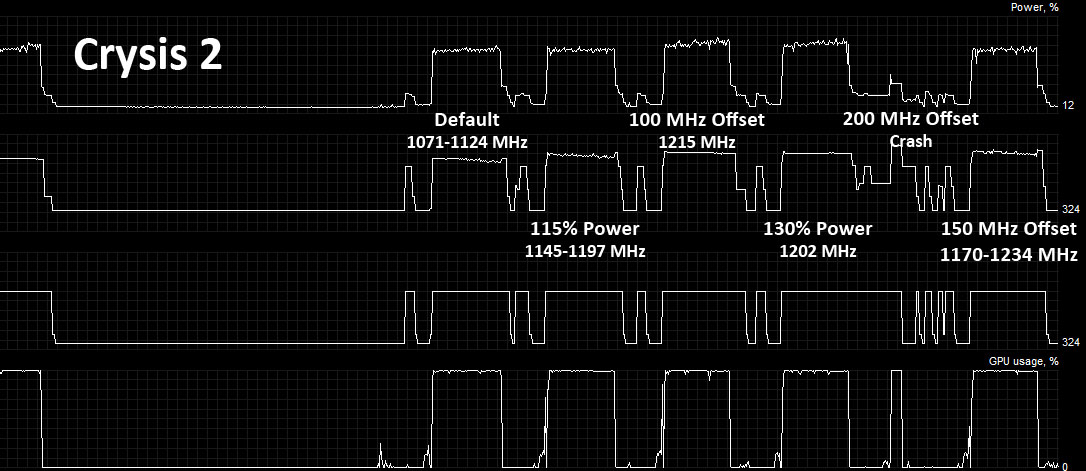GeForce GTX 680 2 GB Review: Kepler Sends Tahiti On Vacation
Enthusiasts want to know about Nvidia's next-generation architecture so badly that they broke into our content management system and took the data to be used for today's launch. Now we can really answer how Kepler fares against AMD's GCN architecture.
Overclocking: I Want More Than GPU Boost
The implementation of GPU Boost does not preclude overclocking. But because you can’t disable GPU Boost like you might with Intel’s Turbo Boost, you have to operate within the technology’s parameters.
For example, overclocking is now achieved through an offset. You can easily push the base 3D clock up 100, 150, or even 200 MHz. However, if a game was already TDP-constrained at the default clock, it won’t run any faster. In apps that weren’t hitting the GTX 680’s thermal limit before, the offset pushes the performance curve closer to the ceiling.
Because GPU Boost was designed to balance clock rate and voltage with thermal design power in mind, though, overclocking is really made most effective by adjusting the board’s power target upward as well. EVGA’s Precision X tweaking tool includes built-in sliders for both the power target and the GPU clock offset.
Although GeForce GTX 680’s TDP is 195 W, Nvidia says the card’s typical board power is closer to 170 W. So, increasing the power slider actually moves this number higher. At +32%, Precision X’s highest setting is designed to get you right up to the 225 W limit of what two six-pin power connectors and a PCI Express slot are specified to deliver.
Using Crysis 2 as our very-consistent test case, we can measure the impact of each different alteration and its effect on performance.
First, we launch a single run of the Central Park level at 1920x1080 in DirectX 11 mode, without anti-aliasing. We get a 72.3 FPS result, and we observe GPU Boost pushing the GeForce GTX 680 between 1071 and 1124 MHz during the run (up from the 1006 MHz base).
The top chart shows that we’re bouncing around the upper end of GK104’s power ceiling. So, we increase the target board power by 15%. The result is a small jump to 74.2 FPS, along with clocks that vacillate between 1145 and 1197 MHz.
Get Tom's Hardware's best news and in-depth reviews, straight to your inbox.
Figuring the power target boost likely freed up some thermal headroom, we then increase the offset by 100 MHz, which enables even better performance—76.1 FPS. This time, however, we get a constant 1215 MHz. Nvidia says this is basically as fast as the card will go given our workload and the power limit.
So why not up the target power again? At 130% (basically, the interface’s 225 W specification), performance actually drops to 75.6 FPS, and the graph over time shows a constant 1202 MHz. We expected more performance, not less. What gives? This is where folks are going to find a problem with GPU Boost. Because outcome is dependent on factors continually being monitored, performance does change over time. As a GPU heats up, current leakage increases. And as that happens, variables like frequency and voltage are brought down to counter a vicious cycle.
The effect is similar to heat soak in an engine. If you’re on a dynamometer doing back to back pulls, you expect to see a drop in horsepower if you don’t wait long enough between runs. Similarly, it’s easy to get consistently-high numbers after a few minute-long benchmarks. But if you’re gaming for hours, GPU Boost cannot be as effective.
Our attempt to push a 200 MHz offset demonstrates that, even though this technology tries to keep you at the highest frequency under a given power ceiling, increasing both limits still makes it easy to exceed the board’s potential and seize up.
Sliding back a bit to a 150 MHz offset gives us stability, but performance isn’t any better than the 100 MHz setting. No doubt, it’ll take more tinkering to find the right overclock with GPU Boost in the mix and always on.
Current page: Overclocking: I Want More Than GPU Boost
Prev Page GPU Boost: Graphics Afterburners Next Page PCI Express 3.0 And Adaptive V-Sync-
outlw6669 Nice results, this is how the transition to 28nm should be.Reply
Now we just need prices to start dropping, although significant drops will probably not come until the GK110 is released :/ -
Scotty99 Its a midrange card, anyone who disagrees is plain wrong. Thats not to say its a bad card, what happened here is nvidia is so far ahead of AMD in tech that the mid range card purposed to fill the 560ti in the lineup actually competed with AMD's flagship. If you dont believe me that is fine, you will see in a couple months when the actual flagship comes out, the ones with the 384 bit interface.Reply -
Chainzsaw Wow not too bad. Looks like the 680 is actually cheaper than the 7970 right now, about 50$, and generally beats the 7970, but obviously not at everything.Reply
Good going Nvidia... -
rantoc 2x of thoose ordered and will be delivered tomorrow, will be a nice geeky weekend for sure =)Reply


